Notable race Time Lord | ||
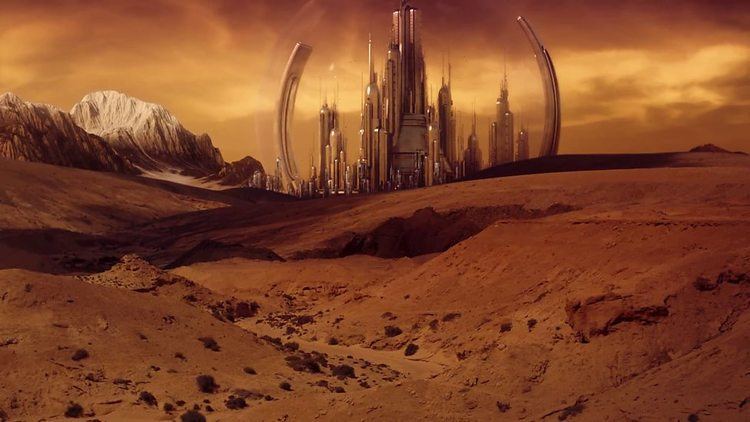 | ||
Notable locations Citadel, Panopticon, Arcadia, Academy, Death Zone, Eye of Harmony, Continent of Wild Endeavour, Mountains of Solace and Solitude, Mount Perdition Genre Science fiction television Notable people | ||
Dr who soundtrack this is gallifrey
Gallifrey (/ˈɡælᵻfreɪ/ or /ˈɡælᵻfriː/) is a planet in the long-running British science fiction television series Doctor Who. It is the original home world of the Doctor, The Master, and The Rani, as well as other Time Lords that have been seen in the show. It was located in a binary star system within the constellation of Kasterborous, at "galactic coordinates ten-zero-eleven-zero-zero by zero-two from galactic zero centre".
Contents
- Dr who soundtrack this is gallifrey
- Geography and appearances
- Spin off material
- History
- On screen
- Novels
- References
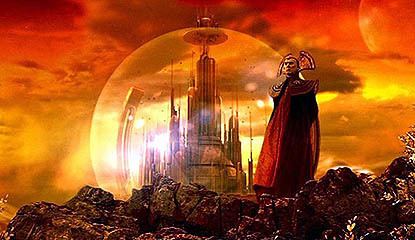
During the first decade of the television series, the name of the Doctor's home planet was not revealed, although it was actually shown for the first time in The War Games (1969) during the Second Doctor's trial. It was finally identified by name for the first time in The Time Warrior (1973–74). It is never definitively stated when the appearances of Gallifrey in the television series take place. As the planet is often reached by means of time travel, its relative present could conceivably exist almost anywhere in the Earth's past or future.
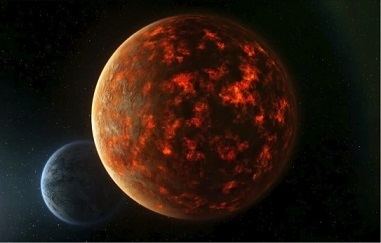
Gallifrey's position in the revived series (2005 onwards) was filled in slowly over the first three years of the series' run. In the series 1 episode "The End of the World", the Ninth Doctor describes the planet as "rocks and dust", "dead [...] before its time" and having "burnt" like the Earth had done in the year 5 billion in a "war" the Doctor's people had lost. The planet was not referred to by name after the show's return in 2005 until the 2006 Christmas special, "The Runaway Bride". It was depicted in a flashback in "The Sound of Drums" in series 3 and played an important role in the plot of The End of Time (2009–10). It appeared briefly in the seventh series finale, "The Name of the Doctor", which shows the moment the First Doctor and Susan stole the TARDIS. Gallifrey is revealed at the conclusion of "The Day of the Doctor" (2013) to have survived the "(Great) Time War" and didn't burn as the Doctor originally believed, though it was frozen in time and shunted into another dimension, before returning to the universe at some point before "Hell Bent" (2015).

Geography and appearances
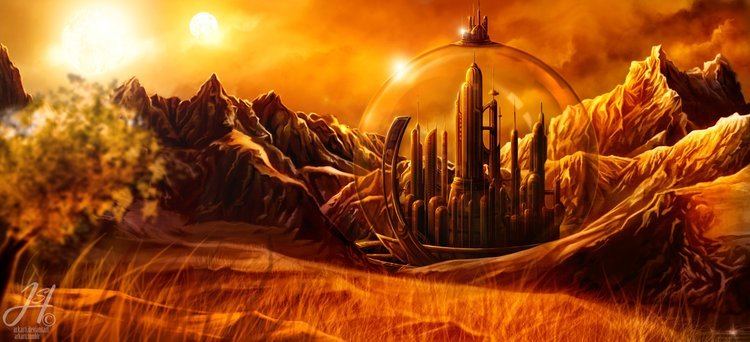
From space, Gallifrey is seen as a yellow-orange planet and was close enough to central space lanes for spacecraft to require clearance from Gallifreyan Space Traffic Control as they pass through its system. The planet was protected from physical attack by an impenetrable barrier called the quantum force field, and from teleportation incursions by the transduction barrier—which could be reinforced to repel most levels of this type of technological attack.
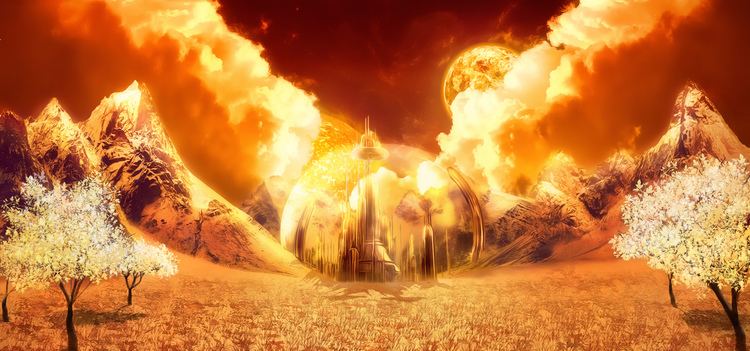
"The Name of the Doctor" presents images of the Time Lord capital. Outside the Capitol is a wilderness with its iconic red grass.
The Doctor's granddaughter Susan first describes her home world (not named as "Gallifrey" at the time) as having bright, silver-leafed trees and a burnt orange sky at night in the serial The Sensorites (1964). This casts an amber tint on anything outside the city, as seen in The Invasion of Time. However, Gallifrey's sky appears blue and Earth-like in The Five Doctors (1983) within the isolated Death Zone.
In The Time Monster, the Third Doctor says that "When I was a little boy, we used to live in a house that was perched halfway up the top of a mountain", explaining, "I ran down that mountain and I found that the rocks weren't grey at all—but they were red, brown and purple and gold. And those pathetic little patches of sludgy snow were shining white. Shining white in the sunlight." In "Gridlock", the Tenth Doctor echoes Susan's description of the world now named as Gallifrey and goes further by mentioning the vast mountain ranges "with fields of deep red grass, capped with snow". He then elaborates how Gallifrey's second sun would "rise in the south and the mountains would shine", with the silver-leafed trees looking like "a forest on fire" in the mornings.
Outer Gallifrey's wastelands are where the "Outsiders" reside, The Doctor Who Role Playing Game released by FASA equates the Outsiders with the "Shobogans", who are briefly mentioned in the serial The Deadly Assassin. The wastes of Gallifrey include the Death Zone, an area that was used as a gladiatorial arena by the first Time Lords, pitting various species kidnapped from their respective time zones against each other (although Daleks and Cybermen were considered too dangerous to use). Inside the Death Zone stands the Tomb of Rassilon, the founder of Time Lord society.
Somewhere on Gallifrey there is also an institute called the Academy, which the Doctor and various other Time Lords have attended.
The 2013 minisode "The Last Day" mentions birds as something expected in Gallifrey's skies. Gallifrey appeared in the Doctor Who 50th anniversary special, "The Day of the Doctor" which aired on November 23, 2013.
Spin-off material
Several of the spin-off novels have further information about Gallifrey. It is said to have at least two moons, one being the copper-coloured Pazithi Gallifreya (first named in Cat's Cradle: Time's Crucible); the novel Lungbarrow also places Karn (setting of The Brain of Morbius, 1976) in Gallifrey's solar system, along with a frozen gas giant named Polarfrey and an "astrological figure" of "Kasterborous the Fibster". Cat's Cradle: Time's Crucible also mentions edible rodent-like mammals called tafelshrews.
History
For general Time Lord history, see History of the Time Lords.On screen
Few details on the history of the planet itself emerge from the original series run from 1963–1989. In "The End of the World" (2005), the Ninth Doctor states that his home planet has been destroyed in a war and that he is the last of the Time Lords. The episode also indicates that the Time Lords are remembered in the far future. Subsequently, in "Dalek" (2005), it is revealed that the last great Time War was fought between the Time Lords and the Daleks, ending in the obliteration of both sides and with only two apparent survivors; the Doctor and a lone Dalek that had somehow fallen through time and crashed on Earth. At the conclusion of that episode, that surviving Dalek self-destructs, leaving the Ninth Doctor believing that he was the sole survivor of the Time War. However, the Daleks return in "Bad Wolf"/"The Parting of the Ways" (2005), and subsequently in several other stories.
The Tenth Doctor's reference to Gallifrey in "The Runaway Bride" (2006) is the first time the name of his homeworld has been given onscreen since the new series began. The Doctor's revelation that he is from Gallifrey elicits terror from the Empress of the Racnoss. The Tenth Doctor in human form (as "John Smith") mentions Gallifrey in "Human Nature" (2007) and is asked if it was in Ireland; this is the same question asked in the 1970s stories The Hand of Fear and The Invisible Enemy.
The planet makes its first appearance in the revived series in "The Sound of Drums" (2007), where the Citadel, enclosed in a glass dome (as described by the Doctor in "Gridlock", 2007), is seen in flashback as the Doctor describes it. Also seen is a ceremony initiating 8-year-old Gallifreyans — in particular the Master — into the Time Lord Academy.
The End of Time (2009–10) once again featured Gallifrey. By the end of the war, Gallifrey is depicted in ruins. The dome of the main city, the Time Lord capital, the Citadel, is shattered and dozens of Dalek saucers have crashed on the plains below. The Master releases Gallifrey from its time lock. However, Gallifrey's reemergence is eventually stopped and reversed after it is made clear that the release of Gallifrey would lead to the Time Lords destroying time — in effect destroying the universe — in order to defeat the Daleks and ultimately to preserve the Time Lords at the expense of all creation. Lord President Rassilon also believes that this action would elevate them to a higher form of existence, becoming "creatures of consciousness". Upon realising the scope of Rassilon's plan for self-preservation, the Tenth Doctor recalls that the Doctor that fought in the Time War had attempted to stop them during the war. Eventually, the Master comes to the aid of the Tenth Doctor and prevents Rassilon and the rest of Gallifrey from coming through, breaking the link that held Gallifrey in relative time to 21st century Earth.
It is stated by the Tenth Doctor in The End of Time that Gallifrey is not how he and the Master knew it in their youth. Implying that the Time Lords had resorted to desperate and deplorable measures to fight the Daleks, the Doctor is willing to break his code of non-violence to stop the return of the Time Lords. This is reinforced within a short feature that discloses the hitherto unknown circumstances of the Eighth Doctor's regeneration into the War Doctor, entitled "The Night of the Doctor" (2013). A young pilot rejects assistance from the Eighth Doctor due to her fear of the Time Lords.
In the series seven finale, "The Name of the Doctor", two Time Lords were seen on Gallifrey watching the First Doctor and Susan steal a TARDIS.
In the 50th anniversary special of the television series, "The Day of the Doctor" (2013), scenes are shown during the fall of Arcadia, Gallifrey's second city. Subsequently it is shown that Gallifrey wasn't actually destroyed. The final scenes depict three of the Doctor's incarnations—the Tenth Doctor, the Eleventh Doctor and the War Doctor; the interface of the weapon, the Moment, that was supposed to destroy the planet; and the Eleventh Doctor's companion Clara Oswald decide against destroying it. Instead, they freeze the planet in time within a parallel pocket universe. This occurs with the help of the other Doctors, including the Twelfth Doctor, whose eyes alone are seen at this point. Instead of destroying Gallifrey, the Dalek fleet echelons open fire on and destroy each other.
In "The Time of the Doctor" (2013), the Time Lords are depicted as trying to re-enter the universe through a crack in the Universe on the planet Trenzalore. They broadcast a message throughout space and time, the question "Doctor Who?", a question which only the Doctor could answer. When the Doctor answers, they will know that it is safe to leave. However, this message inadvertently attracts various races, including the Daleks and Cybermen, to lay siege to Trenzalore; the Eleventh Doctor remaining to protect the inhabitants, but not wanting to release the Time Lords as this would mean the destruction of Trenzalore and the initiation of another Time War. Hundreds of years later, Clara convinces the Time Lords to help the Doctor, dying from old age in his final regeneration, and the crack closes, before reopening in the sky above Trenzalore. The Time Lords give the Doctor a new regeneration cycle, before the crack seals for good with the Time Lords still lost, but a newly regenerated Twelfth Doctor ready to find them. In "Death in Heaven" (2014), Missy tells the Twelfth Doctor that Gallifrey is located at its original coordinates. These claims prove to be false, leaving the Doctor distraught.
The Twelfth Doctor returns to Gallifrey in "Heaven Sent" (2015), having taken the "long way around" through breaking a wall of azbantium after he is teleported inside his confession dial. In "Hell Bent" (2015), Gallifrey is revealed to have come back from the universe it was frozen in, and is now situated "several billion years in the future, and [when] the universe is pretty much over" for its own protection. After Rassilon is deposed and exiled by the Twelfth Doctor, Gallifrey is seen in a much later period in the episode abandoned apart from the human immortal Ashildr, who is protected in the Cloisters beneath the Citadel by a reality bubble.
Novels
Various spin-off novels have expanded on the history and nature of Gallifrey.
Marc Platt's novels Cat's Cradle: Time's Crucible and Lungbarrow, provide a detailed backstory for the civilisation seen in the main series. In the Dark Times (occasionally mentioned in the televised serials such as The Five Doctors), Gallifrey was at the centre of an empire covering dozens of worlds and continually being extended by heroes such as Prydonius (whom the Time Lord chapter is named after). Ancient Gallifreyans are all telepathic and were ruled by a female cult centred on a figure called the Pythia, who controlled the population through mysticism and prophecies. When the prophetic powers of the last of the Pythias failed her, Rassilion, Omega and a shadowy figure known as The Other seized power in the name of science and rationality. Seeing this, the Pythia committed suicide and cursed Gallifrey, killing all children in their wombs and making the world sterile. To combat this, Rassilion restructured society and used genetic looms to create new generations of Gallifreyans, who emerge from the looms as fully grown adults. Each of the Great Houses is allotted a total of forty-five cousins and given a regeneration cycle of thirteen lives. The Houses themselves are to some degree alive, in the same way TARDISes are, and the furniture can move about, occasionally growing into 'Drudges' who function as servants for the family. The Doctor was loomed in the House of Lungbarrow in the mountains of South Gallifrey, but unique among the house's cousins, he has a belly button. This sterility backstory is contradicted by on screen depictions and descriptions of the Master and the Doctor as children, the Eleventh Doctor stating he slept in the cot he brings out of his TARDIS and references made to the Doctor and the Master having parents, the Doctor himself being a father and the Master having a daughter.
The Virgin New Adventures establish a religion on Gallifrey centred around the three main gods, Time, Death and Pain. The Time Lords use these figures to understand the concepts they represent and in some cases make deals with them and become their chosen champions. The Seventh Doctor is Time's Champion (as well as someone who makes frequent deals with or wages against Death to save his friends) and the audio play Master states that the Master is Death's champion. It's also briefly implied in Vampire Science, that the Eighth Doctor is Life's champion, implying the existence of another unseen figure. Happy Endings and other books imply that these gods are Eternals as seen in the serial Enlightenment.
In the Eighth Doctor Adventures novel The Ancestor Cell by Peter Anghelides and Stephen Cole, Gallifrey is destroyed as a result of the Eighth Doctor's desire to prevent the voodoo cult Faction Paradox from starting a war between the Time Lords and an unnamed Enemy. Hints about this future war are dropped in several books earlier in the series beginning with Lawrence Miles' Alien Bodies. In order to have boltholes or decoys in case of attack, the Time Lords have created nine separate planet Gallifreys (it even hinted that the original Gallifrey may at some point be reduced to ruins) and special looms to constantly produce new soldiers. By this time TARDISes have evolved to point where they appear human and reproduce sexually (the Doctor's companion Compassion is the first such TARDIS). It is also hinted that the Celestial Intervention Agency will evolve into the beings of pure thought known as the Celestis, who observe the war from outside this dimension (the Last Parliament in which they sit resembles the Panopticon on Gallifrey and the closest anyone gets to describing them is similar to the Time Lords' robes). Faction Paradox itself is a counter to Time Lord society, dedicated to creating time-travel paradoxes, in contrast to the Time Lords' web of time. It was founded by a mysterious figure Grandfather Paradox, who it is believed was once a Time Lord from the House of Lungbarrow. The Ancestor Cell suggests that he is a future version of the Doctor, but this is retconned in The Gallifrey Chronicles, to him being everyone's potential future self. When the Doctor destroys Gallifrey the war no longer happens and his actions also apparently (and retroactively) wipe the Time Lords from history.
In the last regular Eighth Doctor novel, The Gallifrey Chronicles by Lance Parkin, it is revealed that while Gallifrey was destroyed, the Time Lords were not erased from history. However, the cataclysm sets up an event horizon in time that prevents anyone from entering Gallifrey's relative past or travelling from it to the present or future. The Time Lords also survive within the Matrix, which has been downloaded into the Eighth Doctor's mind, but their reconstruction requires a sufficiently advanced computer. At the novel's end, the question of whether or not the Time Lords will be restored remains unanswered.
Television series executive producer Russell T Davies wrote in Doctor Who Magazine #356 that there is no connection between the War of the books and the Time War of the television series. In the same Doctor Who Magazine column, Davies compared Gallifrey being destroyed twice with Earth's two World Wars. He also said that he was "usually happy for old and new fans to invent the Complete History of the Doctor in their heads, completely free of the production team's hot and heavy hands".
